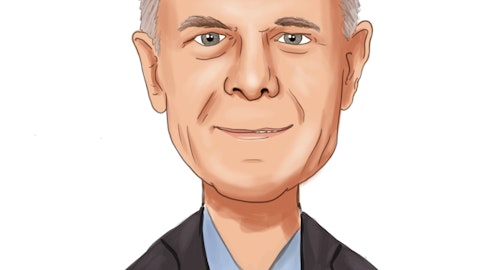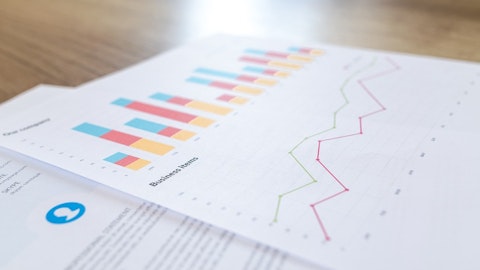Eric Ashleman: And then really past that, I mean, we did say there’s some customer points that we have that they don’t have that over time, we think, are interesting and we could exploit those. And that’s very interesting things on the kind of codevelopment fronts, but the cycle of those are going to be further out in the future. So this always kind of was a game of capitalizing on the near-term strength and success of that business in those markets with sort of this additive element that we’re going to work over time to enrich it with all the IDEXX assets.
Bryan Blair: Definitely makes sense. And given the composition of Man Group, the — from what I can see at least 5 businesses, I’m not certain divisions or platforms they’re in. Are there any unique aspects of integration that you would call out? And I guess just to level set, obviously, this is a growth opportunity. But are there cost synergies?
Eric Ashleman: I mean, not so much within the IDEXX topology and things like that. I mean some certain things we do to leverage back office and being part of the company. But it’s not kind of a classic story of us kind of putting things together and moving plants around. The — as you often see in businesses like this, I mean a lot of that technology is resident in people. I think the single biggest lever that we anticipate pulling here absent that 1 is 80-20. I mean it’s just the implementation of that model. And I can absolutely assure you their profile is very IDEX-like out of the gate, which means there are opportunities there to streamline and simplify it.
Bryan Blair: Okay. Excellent. And 1 last one, if I can. You’ve called out an increase in project activity in municipal water. — over recent quarters, there’s obviously a lot of funding for domestic projects. Are you willing to offer some finer points on that front? How much the project funnel has expanded anticipated 2023 growth? Anything along those lines?
Eric Ashleman: Yes. I mean it’s — of course, it manifests itself across a series of franchises and very kind of different technologies that we have. So I would probably just roll back to very, very positive. The quote activity has been strong here at the end of last year continues into this year for all of the dynamics that you’re citing, everything from EPA funding and enforcement possibilities, which has always been a catalyst for the businesses that we own now. as well as broader infrastructure support over time, which always takes a little longer to land but also has a potential to extend some of the growth time frames that we’re thinking about into the future. So we’re well positioned. We’re continuing to kind of work those assets together. And then — and this is an area of focus for us as we think about deploying some capital to.
Operator: Our next question is from Brett Linzey with Mizuho Americas.
Brett Linzey : Just wanted to come back to the excess OEM inventory comment. Any sense in terms of months or weeks of inventory on hand at those OEs that needs to get worked down? And then — any color or specific product customer segments that you’re referring to there?
William Grogan: No. I think from a segment, I think it’s most of — we described within some of the comments within our life sciences and total instrumentation, the folks in that group from a magnitude perspective on what they’re holding in from inventory, I wouldn’t speak to that other than just conversations with them, there is a calibration period that we’re going through. As Eric highlighted earlier in the call, this isn’t atypical to what we’ve seen historically we’ve gone through really robust cycles of growth. There is a quarter or 2 of recalibration to normalize and then back off. I think as you hear any of the external commentary for those large customers, they are still bullish on their equipment deliveries and the growth that they’re going to see in 2023.
Brett Linzey : All right. Makes sense. And then just shifting to the resource investment you contemplated for the guide. $0 to $0.20. I mean certainly a wide range given the macro and understand that. But historically, I’d say IDEX consistently invested regardless of the state of the environment. What type of situation really drives you to that lower end? And then maybe just a little color on some of the various projects that are being contemplated there.
Eric Ashleman: Absolutely. We always think of investing and investing for the future and investing to grow. One of the great things about a company like ours, though, is we can move things around sideways. — a lot to help us kind of hit the lower end of that range and still make the right choices for the right businesses. And so whenever you see us talking about stuff like a 0, it’s actually still very dynamic here. it’s just to be candid, we would take businesses that are in softer parts of the universe, and we would quite intentionally like pull those down, lead them out a lot. And redistribute those costs elsewhere to parts of IDEXX that are stronger, sometimes literally taking the same people. and putting them over in stronger parts of IDEXX. So we actually have that nice optionality down at the lower end of the range, but keeps it all moving and allows us to kind of weather a storm if it happens.
Operator: And our final question is from Joe Giordano with Cowen and Company.
Joseph Giordano: Just a couple of follow-ups on orders here. So if I look at HST, obviously, the orders there on an organic basis, the weakest across the portfolio, but the growth for the year on revenue expected to be the best. Like — so when — at what point kind of as you get through the year, do you need to see orders start to stabilize or start accelerating again before like you get a little bit more concerned about the organic revenue profile going forward.
William Grogan: Yes. I think we have a while. HST is our biggest backlog. They’ve built the most backlog out of the 3 segments. So really comfortable with their position here as we go through the first half of the year. We said this calibration on the OEM inventory levels is generally a quarter maybe it spreads into the second. So we’re confident that we’re going to see that start to pick up and move as we progress into the back half of the year.
Joseph Giordano: And then similar on FMT — sorry, on diversified dispensing is a headwind this year on a revenue basis, but it looks like orders kind of picked back up to almost essentially peak levels that you saw like a year ago. So are you starting to see that? Like do you feel more comfortable about the visibility? Are those like 24 orders, I guess, essentially for dispensing that you’re getting on.
William Grogan: No, the Q4 we got for dispensing will book in the second and third quarter of this year. Yes, Dispensing orders were up 25%, but their sales were down 20-plus percent in the fourth quarter. So this is — that was the 1 last order to give us kind of the full set of visibility to still reasonable performance, but down, that’s going to mask a little bit of the strong organic growth that we expect from Fire & Safety and Bandon next year.
Joseph Giordano: You’d expect the dispensing orders to move back down —
William Grogan: I mean, sorry, verified orders to move back down from like fourth quarter levels.




